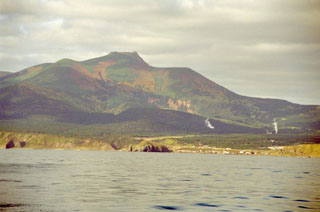Report on Raususan [Mendeleev] (Japan - administered by Russia) — April 1987
Scientific Event Alert Network Bulletin, vol. 12, no. 4 (April 1987)
Managing Editor: Lindsay McClelland.
Raususan [Mendeleev] (Japan - administered by Russia) Intense fumarolic and solfataric activity
Please cite this report as:
Global Volcanism Program, 1987. Report on Raususan [Mendeleev] (Japan - administered by Russia) (McClelland, L., ed.). Scientific Event Alert Network Bulletin, 12:4. Smithsonian Institution. https://doi.org/10.5479/si.GVP.SEAN198704-290020
Raususan [Mendeleev]
Japan - administered by Russia
43.979°N, 145.733°E; summit elev. 882 m
All times are local (unless otherwise noted)
In the explosive crater area on the volcano's E slope intense fumarolic and solfataric activity was occurring during a 6 November aerial survey.
Geological Summary. Raususan, also known as Mendeleev, is a low compound stratovolcano located in the southern part of Kunashir Island. The dominantly andesitic-dacitic volcano is cut by two nested calderas, the larger 6-7 km in diameter and the smaller 3-3.5 km. A central cone that formed inside the younger caldera was breached to the west by a large debris avalanche about 4200 years ago. A lava dome that grew inside the avalanche scarp forms the 888 m high point of the volcano. Additional lava domes in the northern part of the older caldera are considered to represent flank activity of the younger caldera. The only unambiguous historical eruption was a small phreatic explosion in 1880. Four solfatara fields lie at the eastern and northern flanks of the central cone, and a geothermal field is located outside the caldera along the eastern coast.
Information Contacts: G. Steinberg and B. Piskunov, Yuzhno-Sakhalinsk.

